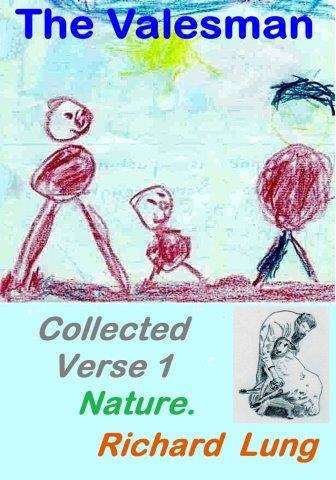
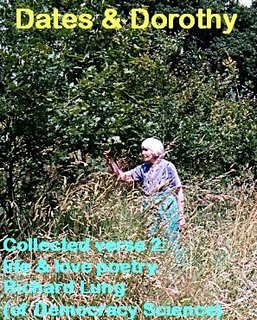
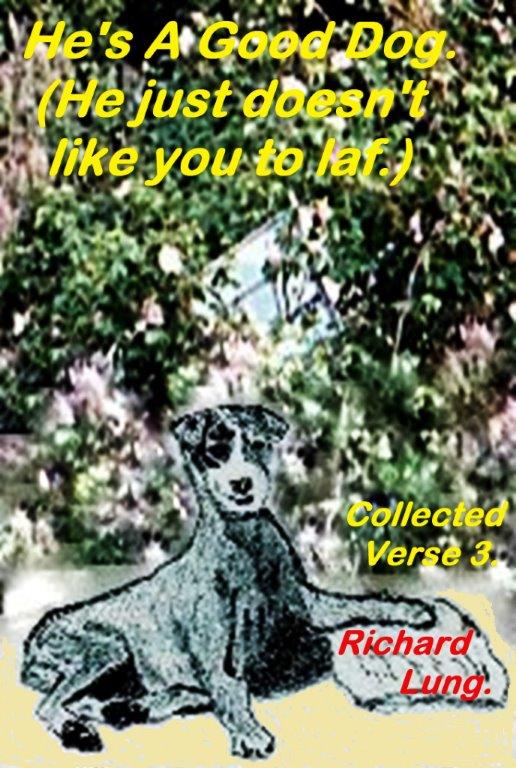
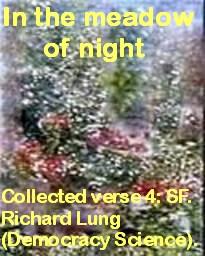
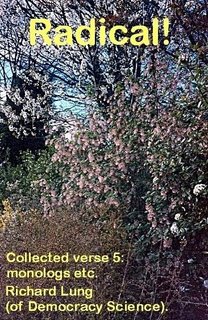
E-book publishers (sometimes in different formats) may have different pricing policies. Not all allow free books. Not all books should be free, as even e-book publishers have to earn a living, like the rest of us. My Amazon kdp profile page links all my published books, to date. Other formats may be available from other sites. Calibre program converts to all the main formats (when I could get it to work properly).
 |
|
 |
 |
 |
 |
Should you like any of these volumes, please review them:
Published on 3rd august 2014.
And is available from Amazon here.
Published on 2nd september 2014.
And is available here
for the Kindle version.
Published on 14 november 2014.
And is available from Amazon here.
Published on 26 january 2015.
And is available from Amazon here.
Published on 3 march 2015.
And is available from Amazon here.
The first volume (160 poems) is classed mainly as nature poetry.
1. How we lived for thousands of years.
2. Flash-backs from the early train.
3. Trickster.
4. OYH! Old Yorkshire Holidays.
The Valesman was a Yorkshire farmer who worked six days a week from dawn to
dusk. His only holiday when he was conscripted to the trenches, sent to France
three times, allowing for recovery from a near fatal shrapnel wound to his
face.
My friend, Dorothy Cowlin, a nature poet, thought my poems about the Valesman
were my best. I would say also some of my bird poems. (She did pick out:
Council of the Braves.)
Starting from an infants point of view, this story in poems sees the animals and birds and beauty spots and seaside holidays of former days.
The cover drawing, of meeting Grandad with his Father, comes from the five-year old at village school. Narrative verse follows the growing boys tricks.
Volume one has something for all ages.
The second volume (169 poems plus two short essays) is classed as of life
and love poetry.
The Dates, of the title, are both historical and romantic, respectively in the
first and third sections.
1. Dates.
2. the Dorothy poems.
3. Loves loneliness, loves company.
4. the romance of religion.
Followed by two short essays.
5. Literary review of Dorothy Cowlin.
Volume 2 is vaguely structured on the Four Loves, as presented by CS Lewis in the book of that title: affection, friendship, eros (romance), charity (religious love). Part one perhaps doesnt have much to do with affection But part two is about Dorothy Cowlins friendship. Part three is romantic. Part four is religious or spiritual.
Dorothy was warmly responsive to the romantic lyrics of the third section. This was reassuring because some originated in my twenties. I gave-up writing verse in my thirties. These surviving early poems, like most of my out-put, under-went intensive revision.
The fourth section may stem from the importance attached to religion at primary school. Here humanitarian Dorothys influence was conspicuous by its absence, except that she liked visiting churches.
The fifth section review of Dorothy as a professional writer is freely available, at present, on my website: Poetry and novels of Dorothy Cowlin. All the text is there, except a preface and last section. Also new are the fotos of Dorothy (including the cover foto above).
I lost access to my Dorothy Cowlin web-site in 2007 and its continued availability is not guaranteed, so I welcome this opportunity to publish my literary review of her work, as an extra to volume 2.
The third volume is a miscellaneous collection of 163 poems/pieces, making-up sections, one, three and four, with the arts and politics the strongest themes, as well as themes found in other volumes. There is also a story in section one, and a final short essay.
1. with children.
2. or animals
3. never act
4. the political malaise
5. the lost
6. short essay:
Proportional Representation for peace-making power-sharing.
"A boot boy in the Great War" is included in the first section. This is a verse novella and dramatic poem, marking the centenary of the First World War. The idea comes from an incident related by Dorothy (yet again). Her uncle was stopped flying a kite on the beach, because he might be signaling to the enemy battle fleet. No kidding!
This volume is of "presentatives" because largely about politics and the arts, with politicians acting like performing artists or representatives degenerating into presentatives on behalf of the few rather than the many.
However, the title poem, He's a good dog..., hints how eccentric and resistent to classification is this third collection. The good dog is derived from a true dog (whose story is told in the volume 1 poem, the bleat dog) and the most fantastic element of the tale is based on a true second world war air incident.
Volume 4 (160 poems plus two short stories):
part one: allure.
The allure of astronomy, the glamor and mystery of the star fields features
here.
part two: endeavor.
The romance and the terror of the onset of the space age and the cold war
loom.
part three: fate.
An uncertain future of technologies and possible dystopias. Ultimate questions
of reality.
Two short stories, on the theme of progress, conclude the volume.
This fourth volume is of SF poetry. That is Science Fiction or Speculative Fiction. The verse ranges from hard science to fantasy.
The literary tradition of HG Wells and other futurists exerts its influence.
Otherwise, I have followed my own star, neither of my nature poet friends, Dorothy and Nikki, having a regard for SF poetry. Yet, the poetry of the earth has always been complemented by the poetry of the heavens, like a tree silhoueted against the constellations. My nature poetry launched my extra-terrestial poetry. This may be my most imaginative collection. As with volume 3, its diversity discourages summary.
Volume 5 opens with a play about the most radical of us all, Mother Teresa:
If the poor are on the moon...
This is freely available, for the time being, on my website: Poetry and novels
of Dorothy Cowlin. (Performers are asked to give author royalties to the Mother
Teresa Mission of Charity.)
The previously unpublished content consists largely of fairly long verse
monologs, starting with artistic radicals, in "Symfonic Dreams," which is a
sequence of The Impresario Berlioz, and The Senses of Sibelius.
Next, the intellectual radical, Sigmund Freud, followed by short poems on a
sprinkling of more great names, who no doubt deserved longer. (Art is long,
life is short.)
The title sequence, Radical! is made-up of verse about John Stuart Mill, Arthur Conan Doyle, George Bernard Shaw, HG Wells, George Orwell and JB Priestley.
Volume five ends with an environmental collection, some of which is freely
available on my website: Poetry and novels of Dorothy Cowlin.
Should that website close down, I hope the (revised) green verses and the
Mother Teresa play can still be obtained in this volume five.
No explicit dedications (except to the Mother Teresa play) preface these
volumes, which dedicate themselves.
All five volumes are with notes, acknowledgments and after-words.
Writings from this site, by Richard Lung, were edited and augmented into a series of e-books.
Except this one, where the short-hand system Single-stroke English was not first introduced on my web-site. This is the summary edition:
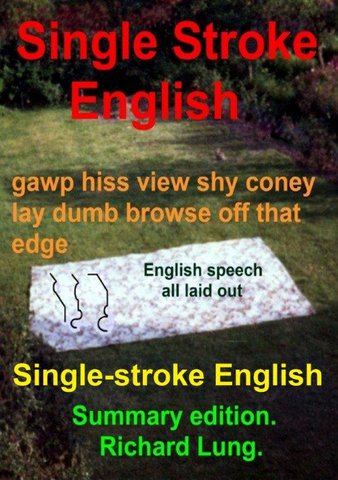
Book one:
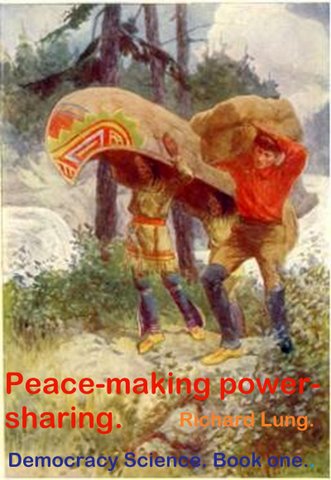
The first, of two books on voting method and electoral reform, "Peace-making
Power-sharing" features new approaches, like the Canadian Citizens Assemblies
and referendums.
I followed and took part in the Canadian debate from before the assemblies were
set-up, right thru the referendums.
This was a democratic tragedy and an epic in the dashing of idealistic
hopes.
Developments in America are reviewed.
The anarchy of voting methods, from the power struggle in Britain, is investigated over a century of ruling class resistance to democratic improvement.
A penultimate chapter gives the simplest way to explain transferable voting, on to the more formal treatment of a small club election.
The last chapter is the earliest extant version of my work on scientific measurement of elections (in French).
"Peace-making Power-sharing"
It is available for Amazon kindle, here.
Book two:
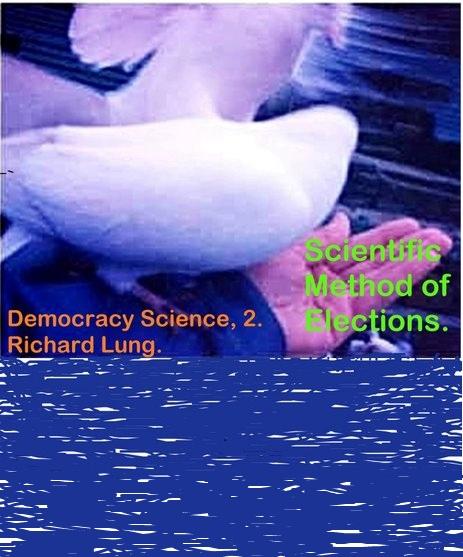
In the first book in the series, the last chapter, in French, is the earliest surviving version of the foundation of this sequel book. I base voting method on a widely accepted logic of measurement, to be found in the sciences. This is supported by reflections on the phiosophy of science.
The more familiar approach, of judging voting methods by (questionable) selections of basic rules or criteria, is critically examined.
This author is a researcher, as well as a reformer, and my innovations of Binomial STV and the Harmonic Mean quota are explained.
(This site is still a source of reference for the large tables used to calculate Binomial STV, because they are too large to conveniently feature in small e-book readers.)
The second book has more emphasis on electoral research, to progress freedom thru knowledge.
Two great pioneers of electoral reform are well represented here, especially speeches (also letters) of John Stuart Mill on parliamentary reform (obtained from Hansard on-line). And there is commentary and bibliography of H G Wells on proportional representation (mainly).
Official reports of British commissions on election systems are assessed. These reports are of Plant, Jenkins, Kerley, Sunderland, Arbuthnott, Richard, and (Helena Kennedy) Power report
The work begins with a short history on the sheer difficulty of genuine
electoral reform. The defeat of democracy is also a defeat for science. Freedom
and knowledge depend on each other.
Therein is the remedy.
Available from Amazon here.
Book 3:
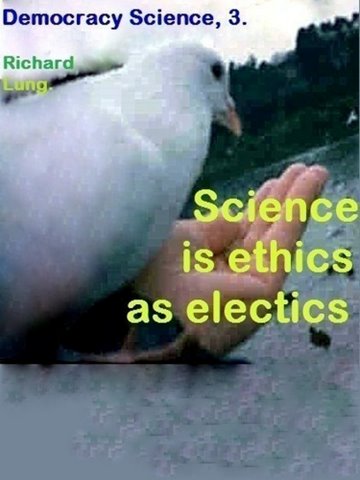
Political elections, that absorbed the first two books in this series, are only the tip of the iceberg, where choice is concerned. Book three, in preparation, intends to take an electoral perspective on the social sciences and natural sciences, from physics to metaphysics of a free universe within limits of determinism and chance.

Forth-coming. General discussions about voting method, followed by a technical account of FAB STV.
En francais / in French:
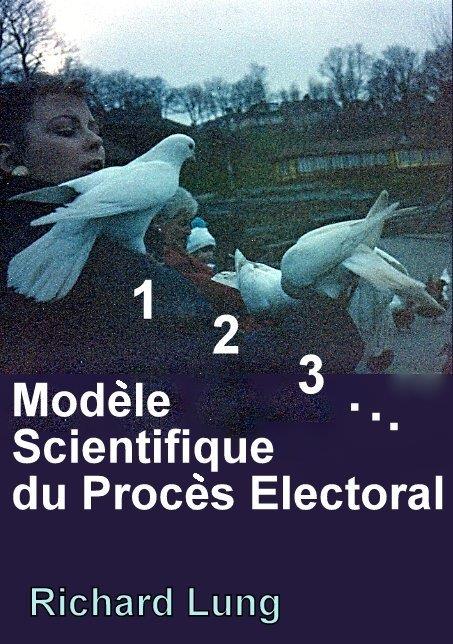
Deux compositions au sujet de la reforme electoral.
Edited version of the UNESCO essay (on this site) plus another essay in French, on electoral reform of the federal parliament in Canada.
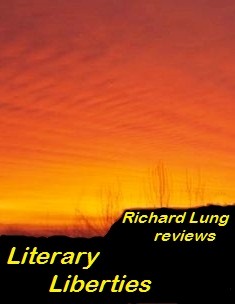
Literary Liberties with reality allow us to do the impossible of being other people from all over the world, making the many worlds theory a fact thru fiction.
This book of books or illustrated reviews span fiction, faction and
non-fiction.
It goes some way to substantiate the belief of Benedetto Croce that history is
the history of liberty.
I only wrote reviews of books that I appreciated, so that I could pass on that appreciation to others. It must be admitted that I went with novels that looked over horizons confined to family values. (Family is, of course, a basic trial of liberty, compromised by obligations to partner and children.)
Likewise, these reviews themselves need not be bounded by the horizons of literary criticism but reach out to solutions for the problem novel or the non-fiction book with a cause.
In promoting others writings, I hoped to promote my own, or rather the liberal values that inform my writings. It took a lot more preparation than I had anticipated. This is usually the case with my books.
Literary Liberties is the first of a short series of Commentaries. This author also has a Democracy Science series. The series of Collected Verse was the first to be completed.
Available from Amazon here.
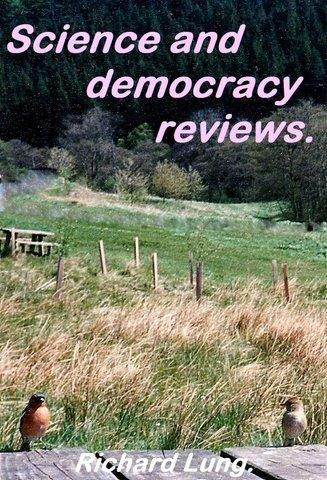
A book of books, on science, mainly physics, and democratic causes old and new. This is an edited and up-dated version, from my two web-sites, with new material.
As they separately pursue their shared ethic of progress, scientific research and democratic reform conduct themselves as two different journeys, both here followed, as the evidence mounts that they depend on each other to meet the stresses that survival poses.
I have drawn on my experience of life and books, in discussing the following works.
The physicist, John Davidson under-took an epic investigation into the mystic meaning of Jesuses teachings, as for our other-worldly salvation, supplemented by a revelation in non-canonic texts of the gnostics.
The Life and Struggles of William Lovett, 1876 autobiography of the "moral
force" Chartist and author of the famous six points for equal
representation.
Organiser who anticipated the peace and cultural initiatives of the UN, such as
UNESCO.
Jill Liddington: Rebel Girls. Largely new historical evidence for the role especially of working women in Yorkshire campaigning for the suffrage.
"How the banks robbed the world" is an abridged description of the BBC2 program explaining fraud in corporate finance, after the 2000-02 Dotcom bubble burst, destroying the investments of ordinary people.
David Craig and Matthew Elliott: Fleeced!
How we've been betrayed by the politicians, bureaucrats and bankers and how
much they've cost us.
The political system fails the eco-system.
Green warnings, over the years, by campaigners and the media, and the hope for
grass roots reforms.
From Paul Harrison, how expensively professionalised services deprive the poor
of even their most essential needs. And how even the developed countries are
over-strained on this account and draw in trained people from deprived
countries.
Why society should deprofessionalise basic skills important for peoples most
essential needs, whether in the third world or the "over-developed"
countries.
The sixth extinction
Richard Leakey and other experts on how mankind is the agent of destruction for
countless life forms including possibly himself, in the sixth mass extinction
planet earth has endured in its history. Why world politicians must work
together to counter the effects of global warming.
On a topic where science and democracy have not harmonised, a few essays from 2006 to 2010, after "nuclear croneyism" infested New Labour and before Japans tsunami-induced chronic nuclear pollution. There's a 2015 after-word.
Some women scientists who should have won nobel prizes.
Lise Meitner, Madame Wu, Rosalind Franklin and Jocelyn Bell, Alice Stewart, to
name some. Reading of their work in popular science accounts led me, by chance,
to think they deserved nobel prizes: no feminist program at work here.
Julian Barbour: The End Of Time.
Applying Mach's principle, to Newton's external frame-work of absolute space
and time, both in classical physics and to Schrödinger's wave equation of
quantum mechanics, by which the universe is made properly self-referential, as
a timeless "relative configuration space" or Platonia.
Murray Gell-Mann: The Quark and the Jaguar.
Themes, including complex systems analysis, which the reviewer illustrates by
voting methods.
Brian Greene: The Elegant Universe.
Beyond point particle physics to a theory of "strings" that may under-lie the
four known forces of nature, and its material constituents, thru
super-symmetry, given that the "super-strings," as such, are allowed to
vibrate, their characteristic particle patterns, in extra hidden dimensions of
space.
Brian Greene: The Hidden Reality.
A survey of the more extravagant physics theories that have invoked many worlds
or a multiverse..
Lee Smolin: Three roads to quantum gravity.
Reviewing the other two roads (besides string theory) namely black hole
cosmology and loop quantum gravity. All three approaches are converging on a
discrete view of space and time, in basic units, on the Planck scale. General
relativity's space-time continuum is being quantised, rather as nineteenth
century thermo-dynamics of continuous radiation was quantised.
Lee Smolin: the trouble with physics.
Impatience with the remoteness of string theory and hope for progress from
theories with more experimental predictions. How to make research more
effective. Smolin's scientific ethic. Reviewer criticises artificial divide
between science and ethics.
Available from Amazon kdp: Science and democracy reviews
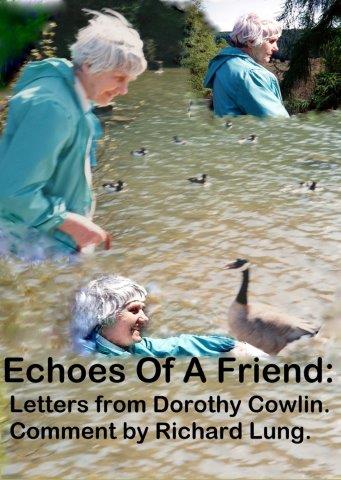
Dates And Dorothy was a literary appreciation of the professional writer,
traveler, nature walker, and poet, combined with my second book of verse, that
includes the story of our friendship. My second book, about Dorothy, is a
memorial, she graces. by speaking thru letters to me, as well as assessments of
this writer, she made into a maker and aided as a reformer.
In widowhood, she yet became companionable and widely liked. Her quiet and
sunny disposition held in reserve a deeply serious nature.
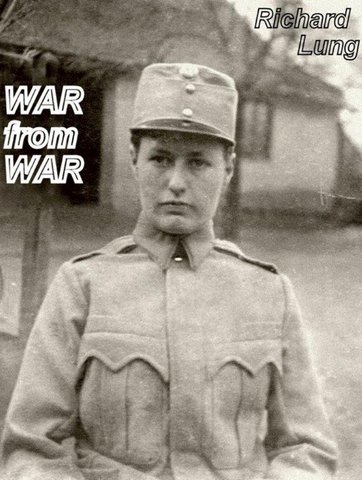
A happy childhood in the Paradise of the Banat. A coming of age, thrown out of the services company, to fight in the Hell of the Russian Front. Purgatory in a foreign land. For, war does not end when the immediate fighting is over and everyone still (more or less) alive has left the battle-field. A man may be brought down instantly by his injuries or, just as inevitably, near the end of a long life. There are also lasting injuries invisible and incalculable in their untoward effects.
My father was descended from German emigrants (to escape the Franco-German wars) settling in Austro-Hungary, caught-up in the Great War, and annexed to Romania. He was conscripted in the second world war, and captured, accepting the offer of work in England, where he was, at first, interned and later naturalised. An artisan by trade, a sportsman by inclination, fighting a long rear-guard action against his war injury.
My fathers story is followed by a kaleidoscope of after-thoughts. I outline answers to the problem of turning war into peace. A supplement includes a long letter in German by a prisoner of war comrade, on returning home.
Bear in mind that electronic book publishing is still an infant technology and fast changing, so that my amateur comments on the technology and business may re-classify as industrial archeology.
Meanwhile, other writers, wishing to publish their own e-books, might find helpful these notes on my experience. There is plenty of information on the web. It was just a question of finding the help that was right for me. I did find it, after a fair bit of searching.
I had no personal tuition. I hired no professional help. I did give a voluntary donation to Kovid Goyal of the Calibre program, because this was for me an essential step to self-publication, which it was only right to acknowledge. That is for the purpose of presenting a type-script in epub format for Smashwords, which distributes your e-book for various e-readers and book-sellers.
The first essential piece of information for publishing an e-book is that
you have to format your book, for an e-book reader, like the Amazon kindle,
which has a distinct format, the mobi file and its successors.
There are also a host of other reading devices, which are largely covered by a
standard format, the ePub format.
My journey to self-publication differed from a lot of web advice. A
widespread assumption is that the writer produces his typescript on a
word-processor like Microsoft Word.
Word uses a lot of complicated code. Moreover, it is closed source code, so you
cannot actually see how it formats your writing.
Your e-book format is required to be quite simple, if your typescript is
going to come out in a presentable fashion on a wide variety of e-readers.
Therefore, a typescript in Word has to have its format stripped down. And you
are working blind, because of the closed source.
I soon found that this approach did not suit me. That did not matter for a plodding web manager, like myself, because e-books, like web pages are written in html (Hyper-Text Mark-up Language).
In fact, e-books will only support a basic sub-class of html code, almost as basic as the simple web pages I had been turning out for the previous fifteen years.
It amazes me to see the complicated source code of any web page taken at random. Now and again I did use an automaticly generated html page saved from a word processor program. But I didnt like the mess and decided to stick, as a rule, to my own simple hand-made html coding.
Thus, the source code of most of my web pages is astonishingly simple compared to normal web pages. I use the Amaya html editor, which is authoritative, coming from W3C, the World Wide Web consortium presided over by Tim Berners-Lee himself, who first wrote this code that made the web possible.
In all the advice on how to self-publish e-books, I don't remember being tipped about using Amaya to format ones e-publication.
Normally, you just type on the document page of the Amaya HTML editor, like a word processor. But the page can be split to show you the parallel source page, to verify that all the text is properly coded for a web browser or an e-book reader.
I had a time-saving tip for any e-book writer, when I was using an old
version of Word (I since used OpenOffice again.). Suppose you have been
dictating with voice software, such as Dragon Naturally Speaking, which
requires a common word processor like Word. Or suppose you have just been
typing.
In any case, when you've finished, don't convert the Word page into HTML. That
just will give you an html page, whose source is full of junk code. It would be
tedious to have to clean that up manually, say, for the ePub format.
Instead, I've found that you can copy the Word page and paste onto Amaya, which strips all the junk code to essentials, when you look on the Amaya source page. This minimises the preparation still to make for the required e-book format
I made sure I wasn't using any of the prohibited html code for e-books. You can find what that is on the Kindle Direct Publishing help pages, along with most else you need to know.
E-books allow the <blockquote> html instruction. But I found that the e-book validator, ePubCheck, seemed particular about how I used it. So, I found it easier just to leave out blockquotes. And I don't think my format looked any the worse for that.
Later, I found out that you have to put inside the blockquote the code for
starting and ending paragraphs, which is <p> and </p> respectively,
inside the blockquote start and end pairs.
After all, I decided to leave in the blockquotes for some forthcoming e-book
literature and science reviews.
Other obligatory changes, from laxer Amaya standards, to ePub standards, included putting <p> and </p> round the a-for-anchor codes. These indicate links and hyperlinks to and from web pages, the essence of the world-wide web. Likewise, the paragraph code had to go round the link to an image source (abbreviated to: img src). All the format rules, including these, are put in angle brackets.
Apart from the links, as an exercise in minimalism, you can almost write a web page of text with this one <p> and </p> code to format a paragraph, given that opening a new web page, with the Amaya editor, automatically will come with a basic framework of codes on the source page.
ePubCheck error notices, at first baffled me, until I found that it was essentially an even more strict html editor than Amaya, making strictures that even Amaya had let by.
The error notices refer to specific lines in the source code of the ePub
file, that Calibre generates from your html file -- you may need the Sigil
program, to read the e-pub source code, and which you submit to the on-line
validator, ePubcheck.
From there (when Calibre worked for me) I refered to my original html file to
make corrections directly. Tho, Calibre also allows you to edit the source
page, of your e-book, that it can generate in the various formats.
In those days, format of my e-books then ceased to be a serious problem. I knew it required just a very simple and very accurate use of html code.
Actually the standard version of html, which I used in my web pages, is called transitional xhtml. Its purpose was to make the web available beyond desk-top Personal Computers to the variety of devices, e-readers included, that have since taken over popular usage.
There are submission alternatives. Making Microsoft word processors hidden
code compatible with simple e-book formats could be frustrating.
Calibre came to the rescue by converting your html file into an ePub file.
Your html file could be in a folder with any images the file links to. It is alright to have more than one html file, say for each chapter of your book. Your table of contents is the equivalent of the index or home page to a web-site.
When you upload your index page to Calibre, the program will automaticly up-load all the linked text and image pages, with it, in the folder. Calibre automaticly saves the whole folder as a zip folder.
Calibre has certain settings for different kinds of reading devices and different formats. I made use of that, to put my draft book, in mobi format, and onto my kindle reader, to see how it looks. Amazon stopped accepting mobi formats. I think it went over to the epub industry standard for e-books.
Mario Lurig (see below reference) advised on settings in the Calibre program
to help ensure, your book file will be compatible with as many e-readers as
possible.
If you have fotos for your book, these may be included with the html file or files in a folder. Calibre converts this package to e-book form. It takes you to the folder. You click on the index page, which links to all your text and image pages in the folder, and Calibre will upload the lot, as a zipped folder.
Calibre has a metadata button to take you to a form to note down your book details. A book conversion button brings to a series of options, which Mario Lurig guides you thru.
For my first few books, I uploaded a zip folder to KDP. These two options
were just how I learned to get by, at the time.
The ePub file integrates text and pictures into one file for upload to the
e-book publisher. This proved to be more robust, for uploading, than the zip
folder.
With a later book, I had difficulty with the KDP conversion of the zip file to a mobi file for the Kindle reader. Then I changed to uploading the ePub file.
Alina Padilla (see reference below) warns you that there is a little extra
bit of html code needed for your html file to Kindle. You need to html code in
an image placement for a sort of thumbnail of the book cover image, at the top
of your html file.
You need to put in a simple HTML code for where the table of contents begins,
and also to code the book title heading for where the book text starts (after
the table of contents).
As a writer of poetry books, I needed to know how to start a new poem on a
new page of an e-reader, which means a great many page breaks.
Mario Lurig (in afore-mentioned reference) showed how to do this, among other
things, with a sample block of code, called an internal style sheet, which is
put, within the hidden top part of the html source page, enclosed by the
<head> and </head> pairs. The visible text is enclosed within the
subsequent <body> and </body> code pairs.
The profits on your book will be taxable automaticly by the US government, unless you are a foreigner, who can claim exemption via a US tax treaty with your own country. Scarlet Cox (see below reference) explains admirably how to claim such exemption. But, on two occasions, at two e-book firms, the tax exemption form would not allow me to confirm my input. That is, if any money were made, it would all go to the U.S. taxman.
Before you've self-published an e-book, there is a great deal of advice on
how to promote it.
If you are a sociable person, already participating in the on-line social
media, as well as having a wide network of friends and associates in ones
personal relationships, then marketing your book may come naturally.
I am not such a person, and can only comment on what happened, when I tried
to follow the advice that you should try to get your book reviewed.
I would have been better off if I had made no attempt at all to seek
reviewers.
What happened was this. All (but one) ignored the offers of my book for
review. In retrospect, that was the good news.
The bad news was the but one review, which was the image of fear and loathing
campaigns that effectively put off voters against referendums. That didn't
matter so much, as that this Amazon review was put on my book page, like having
"incompetant idiot" (or something short enuf to fit) written on my forehead, so
to speak.
My book page was not a review-free zone, where customers could view my book without being told by reviewers what to think about it. I believe this imposition violates the principle of "Without prejudice."
I would rather the browsing customer or searcher on a book page could choose equally between the reviews link or the link to look inside the book.
Reviews are not only on their own review page and on the comments page, they
are on the book page, too. In my opinion, this is not an equitable
arrangement.
Apparently, my fellow authors are happy with the current arrangement.
Meanwhile, I joined Goodreads, which has an author program, only to find my
book promptly given a don't-read rating (by the same reviewer, I only found out
later).
According to rickcarufel, hundreds if not thousands of books are being targeted
in this way. He says this trolling could destroy the Goodreads forum, as it has
other forums, that did not tackle this infestation.
Poetry is an unpopular category, or ghetto where few go, anyway, which is all the more reason that I could do without review confirming and reinforcing that aversion to verse.
Fervent thanks for the following:
Kovid Goyal for his Calibre ebook conversion program. (I made a voluntary donation.)
Mario Lurig: Building an E-Book from HTML: Sample Code.
Alina Padilla of Precise Edit on Converting
to Kindle.
(Tho, the standard Amaya html editor from W3C
put me to the trouble of modifying some parsing errors, in these mark-ups.)
To check your ePub file is up to standard: epub check.
Scarlet Cox: Self-Publisher Tax ID needed, but I’m not a US Citizen! Help!
Not til coming of age did I form a purpose in life. Not til I had secured a college place, which my grades didn't merit, was I even in a position to think of having aims. Sociologists in a little college in Manchester were kind enuf to rescue me, like a stranded seal, tho I turned out a disappointment to them (not to mention myself).
Further education gave me a good grounding in the filosofy of scientific method and basic practical statistics, even putting my lazy head onto proportional representation. Sooner or later, these were to become elements of a lifetime preoccupation.
it is hardly an exaggeration to say that I originally owed everything, my
reaction included, as a thinker, to that social science course. I objected to
their dualism of science and ethics, the besetting sin of academe.
(I've challenged this again with my [retirement-age] web-page: Science is
ethics or "electics.")
As age began to tell, I was getting stuck, until the Internet and the World Wide Web. As for billions of other folks, the web has been a life changer for me. Having a public forum, at last, was the incentive I needed to explain scientific ideas to myself precisely enuf to serve as possible explanations to other people.
Of the ideas I had, before and after the web, I wouldn't like to say the latter were altogether better, but they were much the harder and perhaps rank therefore as a greater accomplishment, in my old age.
In the last 15 years or more, I've been writing web pages of ideas, from my youth and seniority, on my Democracy Science site.
No doubt my desire to change the world stemmed from a barren personal life. I had delusions of becoming a novelist, without realising that is not possible without substantial relationships and a wide knowledge of people.
Much later in life, I had another piece of luck, when I was befriended by
Dorothy Cowlin, former teacher and novelist. She criticised my writings. I'd
abandoned verse a decade previously. I think she found it unreadable but was
too polite to say so. Reading and listening to her poems got me started again
on a new tack.
She reconnected me with my roots in the country and my imagination.
Having reached retirement age, I decided to publish my collected verse, in a
series of five volumes.
Richard Lung.
2014.
Up-dated 20-11-2014; 26-1-2015; 15;26-05-2015.